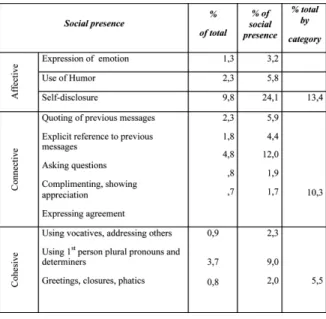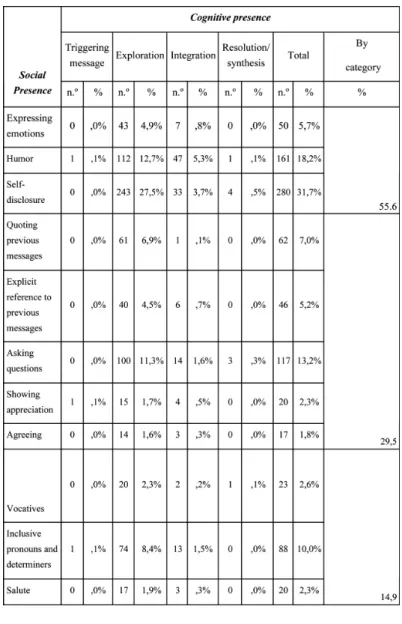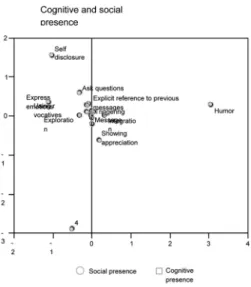SOCIAL PRESENCE AND COGN‹T‹VE PRESENCE IN AN ONLINE
TRAINING PROGRAM FOR TEACHERS OF PORTUGUESE
Idalina Jorge
ifjorge@.ul.pt
University of Lisbon, Portugal
ABSTRACT
Designing activities for on-line courses based on dialogue, such as forums, encouraging interaction between the tutors and the trainees and among trainees has proved to influence positively on students’ motivation, sense of community and engagement. The purpose of this research was to find out if and how social and cognitive presence related in an on-line teachers training program. The teachers training program Navegar no Português (Sailing in Portuguese) was a nationwide project to improve the scientific, didactic and computer skills of the teachers involved. More than 200 teachers, both tutors and students, were organized in 11 regional teams. A content analysis of the messages was conducted and the results indicate that social and cognitive presence can relate differently, more on some categories than on others.
KKeeyy wwoorrddss:: on-line learning; cognitive presence; social presence
INTRODUCTION
This study fits in the post-industrial distance learning research, dedicated to the modalities of dialogue identified by Michael Moore.
The most recent research on collaborative learning in online learning environments has focused on interaction. We need more knowledge about which are the most successful ways to support productive collaboration at different stages of
IODL&ICEM 2010 Joint Conference and Media Days
Idalina Jorge, graduated in German Philology at the Faculty of Arts, University of Lisbon
Post Graduate in Special Needs Education, Faculty of Psychology and Education, University of Lisbon
Master on Distance Learning, Portuguese Catholic University Doctorate on Distance Education in the Faculty of Psychology and Education, University of Lisbon.
Research interests; distance learning, curriculum, computer-mediated communication, social, cognitive and teaching presence, virtual learning environments and communities.
collaborative reflection, what kind of specific help should scaffolding include and what the specific criteria for gradually reducing support are. The present study aims to investigate how social presence relates to collaborative reflection. Both variables are analysed in a multidimensional perspective.
CONCEPTUAL FRAMEWORK
Social presence has been defined as the participants’ ability to project both socially and emotionally (Rourke et al., 2001); cognitive presence has been defined as the participants’ ability to build knowledge and reflect collaboratively (Garrison et al., 2001). Building on the community of inquiry model (Garrison & Anderson, 2003), a research was conducted to relate social and cognitive presence, and verify on which dimensions of both variables the correlation was more evident.
Social presence was operationalized in three categories: 1) affective, 2) interactive and 3) cohesive; all the indicators suggested by Rourke et al. (2001) were adopted, except for maintaining the sequence of the dialogue, since the participants of the program Sailing in Portuguese were continuously encouraged to keep the messages’ sequence, by always hitting the option RESPOND; sentences were adopted as the unit of analysis for this variable.
Cognitive presence has been defined as the participants’ ability of a community of inquiry to build knowledge thorough sustained communication (Garrison & Anderson, 2003).
Cognitive presence has been operationalized in four stages, as suggested by Garrison et al., 2001): 1) triggering event; 2) exploration; 3) integration and 4) resolution; messages were adopted as units of analysis for this variable.
RESEARCH DESIGN
1. Research questions
The research questions tackled in this study are as follows:
Research question 1 (Rl): What is the relationship between the social presence and cognitive presence?
Research question 2 (R2): What dimensions of both variables are more related? 2. Context and participants
the 11th Year curricula and sustaining a national network for debating the new programs.
Eleven regional groups of teachers were organized to constitute a network of research, reflection and practice; about 200 teachers were involved, each regional team having about 16 to 20 teachers, one of them being the tutor, with a trainer’s status conferred by the Continuing Education Coordinating Board.
3. Method
676 forum’s messages with 2512 sentences were used as research material. Given the hybrid nature of asynchronous computer mediated communication, somewhere between oral and epistolary style, with a great amount of sentence-words and sentence segments, exclamations, emoticons, acronyms, punctuation and other expressive strategies, messages were segmented by the researcher and an expert in Linguistics, for the assessment of social presence and then codified by four independent coders, two teachers of Portuguese and two teachers of Philosophy, to assess both social and cognitive presence. The teachers of Portuguese were selected, mainly for their expertise in the linguistic and communication issues involved, since many codification problems were anticipated, such as how to code sentences, either for their structure type or for their communication intention. Two teachers of Philosophy were selected as coders for cognitive presence, since most of this codification often implies much inference.
Correlations among dimensions of social and cognitive presence were established, in order to detect if or how social presence is correlated to cognitive presence.
RESULTS
1. Coding agreement
The percentage of agreement between coders was 86,9% for cognitive presence and 85,0% for social presence; both coders and researcher had to agree upon a unique codification to proceed to the next statistical analyses.
2. Social presence
Social presence = 533,523; sig =,000; V Cramer = ,244;sig =,000) represented 29,2% of the sentences, distributed by affective (13,4%), connective (10,3%) and cohesive (5,5%) sentences, as shown in table 1.
Table 1:Social presence by category
The social presence categories that stand out and move away from the origin , thus having greater explanatory power of the data variation are “Humor”, “Self-disclosure” and “Quoting previous messages”, as shown in figure 1.
3. Cogntive presence
Cognitive presence ( = 692,451; V Cramer =0,303; sig. = 0,000) was mostly composed by exploration items (81,3%), followed by integration messages (13,3%), triggering messages (4,6%) and either resolution or synthesis messages (0,9%). With regard to cognitive presence, only “exploration” and “integration” stand out with some explanatory power, as shown in figure 2.
Figure 2: Cognitive presence
4. Analysis of relationship between social and cognitive presence
Relationships between variables can be explained and better understood in a multidimensional space; techniques of factor analysis of correspondences allow the information ranking, according to their explanatory power. Associations between cognitive and social presence were established by examining the tables of correspondence between the variables whose cells represent the observed frequencies of their categories, the Chi-Square and finally the results of correspondence analysis (ANACOR), to represent graphically the nature of the relationship, where similar categories are closer to each other.
Table 2: Relations between social and cognitive presence
= 64,830 sig. = 0,000 V Cramer =0,156 sig. = 0,000
To measure the correlation between social and cognitive presence, the method of correspondence analysis results was used, showing a low level correlation ( r= 0,125), though a significant one. The choice of explanatory dimensions of the model was confined to the first, because it explains 98% of data variation. The remaining dimensions were excluded from the analysis for not having explanatory power, as shown in table 3.
Table 3:Social and cognitive presence correlations
The correlation between cognitive and social presence only showed evident at the phases of exploration and integration of the first.
In fact, in triggering and resolution messages, social utterances hardly occur. The analysis of significance value associated with chi-square test shows that there is a relationship and dependence between these two variables. The degree of association proves significant, though not intense (r = 0.283).
The stage of exploration is more associated with connectivity and much self-revelation, being both functions represented in a balanced manner.
Results don´t indicate that greater interactivity was associated with higher levels of reflexivity. My data also show that the types of self-disclosure and connectivity increase when the cohesive decrease. The first is associated with early stages of discussion. Once these phases are overcome, relations stabilize at a level of respect and mutual acceptance and students show more focus on cognitive goals.
Methodological ‹ssues
The evolution of collaborative critical reflection has to be inferred by the content of messages and their relationship with adjacent messages. In fact, though the participant moves from reflection to argumentation, the message transcribed bellow ,was categorized in the exploration stage, since it responds only to the initial message of the tutor and expresses a view, based on the participant’s experience. In this message, there many implicitly references to the initial message, but none to other previous messages
In response to the initial challenge [...]my opinion is: 1. It is clear that the medium changes the message ... but this also applies to the sender (...) and the receiver (...)! That is, not just the medium that can change the message. Indeed, the message can be more or less appealing, more or less interesting ( ...), depending on where it is transmitted, the people who send, the people who receive and / or the medium used to transmit. But the use of the medium is important, because something that results with one class, can fail with others (...) 2. The technology can’t work as a catalyst for educational reform, because, as reform does not happen by decree -there must be willingness to change installed practices (...).technology could promote educational reform only if teachers felt the need for it (...) and radically changed their practices (...).3. As for the question “Can technology help solve the problem of passive learning? (...) I cannot comment because I have no experience in this field that will allow me to give an informed opinion.
As for the coding of sentences and units’ categorization, the researcher has to decide on either reinforcing external validity, thus risking much disagreement both on units and codes or reinforcing internal validity, thorough coders’ negotiation, thus reducing external validity.
CONCLUSIONS
The research showed no evidence of greater social interaction being associated with higher levels of collaborative reflection, showing there has be e some of caution, not only for differences in the use of language but also in their communication effects in learning contexts.
However, the data show there could be some relation between social presence and the participants’ sense of well-being and satisfaction. Another issue remains to be tackled regarding the influence of the tutor on social presence.
REFERENCES
Garrison, D. R., Anderson, T. & Archer, W. (2001). Critical thinking and computer conferencing: a model and tool to assess cognitive presence. American Journal of distance education, 15(1), 7-23.
Garrison, R. & Anderson, T. (2003). E-Learning in the 21st Century: A Framework for Research and Practice,2003, p. 23.
Jorge, I. (2001). Navegar no português [ Texto policopiado] : programa on-line de formação de professores de português do ensino secundário : avaliação formativa / Idalina Ferreira Martins Pereira Guerreiro Jorge. Lisboa : [s.n.], 2001.
Jorge, I. (2006). Navegar no português [ Texto policopiado] : programa on-line de formação de professores de português no ensino secundário : reflexão crítica, participação, interacção e tutoria.
Rourke, L., Anderson, T., Garrison, D. R., & Archer, W. (2001). Assessing social presence in asynchronous, text-based computer conferencing. Journal of Distance Education,14(3), 51-70.



